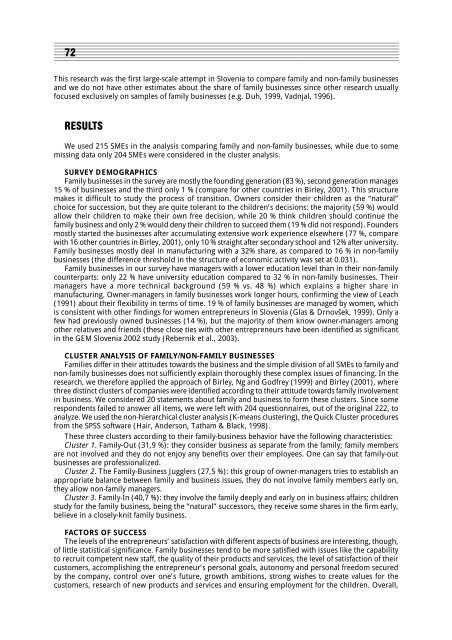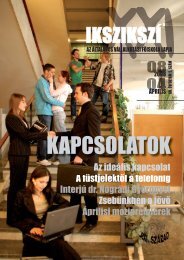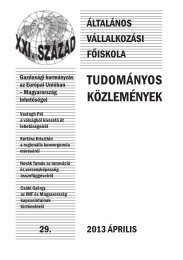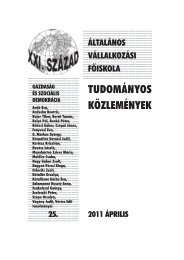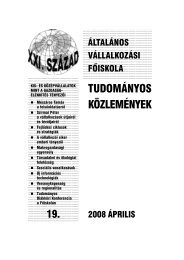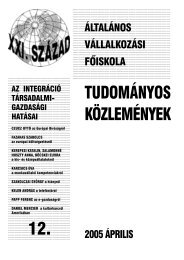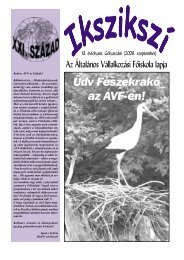Tudástársadalom, vállalkozások, Európa - Ãltalános Vállalkozási ...
Tudástársadalom, vállalkozások, Európa - Ãltalános Vállalkozási ...
Tudástársadalom, vállalkozások, Európa - Ãltalános Vállalkozási ...
Create successful ePaper yourself
Turn your PDF publications into a flip-book with our unique Google optimized e-Paper software.
1234567890123456789012345678901212345678901234567890123456789012123456789012345678901234567890121234567890123456789012312345678901234567890123456789012123456789012345678901234567890121234567890123456789012345678901212345678901234567890123123456789012345678901234567890121234567890123456789012345678901212345678901234567890123456789012123456789012345678901231234567890123456789012345678901212345678901234567890123456789012123456789012345678901234567890121234567890123456789012372123456789012345678901234567890121234567890123456789012345678901212345678901234567890123456789012123456789012345678901231234567890123456789012345678901212345678901234567890123456789012123456789012345678901234567890121234567890123456789012312345678901234567890123456789012123456789012345678901234567890121234567890123456789012345678901212345678901234567890123This research was the first large-scale attempt in Slovenia to compare family and non-family businessesand we do not have other estimates about the share of family businesses since other research usuallyfocused exclusively on samples of family businesses (e.g. Duh, 1999, Vadnjal, 1996).RESULTSWe used 215 SMEs in the analysis comparing family and non-family businesses, while due to somemissing data only 204 SMEs were considered in the cluster analysis.SURVEY DEMOGRAPHICSFamily businesses in the survey are mostly the founding generation (83 %), second generation manages15 % of businesses and the third only 1 % (compare for other countries in Birley, 2001). This structuremakes it difficult to study the process of transition. Owners consider their children as the “natural”choice for succession, but they are quite tolerant to the children’s decisions: the majority (59 %) wouldallow their children to make their own free decision, while 20 % think children should continue thefamily business and only 2 % would deny their children to succeed them (19 % did not respond). Foundersmostly started the businesses after accumulating extensive work experience elsewhere (77 %, comparewith 16 other countries in Birley, 2001), only 10 % straight after secondary school and 12% after university.Family businesses mostly deal in manufacturing with a 32% share, as compared to 16 % in non-familybusinesses (the difference threshold in the structure of economic activity was set at 0.031).Family businesses in our survey have managers with a lower education level than in their non-familycounterparts: only 22 % have university education compared to 32 % in non-family businesses. Theirmanagers have a more technical background (59 % vs. 48 %) which explains a higher share inmanufacturing. Owner-managers in family businesses work longer hours, confirming the view of Leach(1991) about their flexibility in terms of time. 19 % of family businesses are managed by women, whichis consistent with other findings for women entrepreneurs in Slovenia (Glas & Drnovšek, 1999). Only afew had previously owned businesses (14 %), but the majority of them know owner-managers amongother relatives and friends (these close ties with other entrepreneurs have been identified as significantin the GEM Slovenia 2002 study (Rebernik et al., 2003).CLUSTER ANALYSIS OF FAMILY/NON-FAMILY BUSINESSESFamilies differ in their attitudes towards the business and the simple division of all SMEs to family andnon-family businesses does not sufficiently explain thoroughly these complex issues of financing. In theresearch, we therefore applied the approach of Birley, Ng and Godfrey (1999) and Birley (2001), wherethree distinct clusters of companies were identified according to their attitude towards family involvementin business. We considered 20 statements about family and business to form these clusters. Since somerespondents failed to answer all items, we were left with 204 questionnaires, out of the original 222, toanalyze. We used the non-hierarchical cluster analysis (K-means clustering), the Quick Cluster proceduresfrom the SPSS software (Hair, Anderson, Tatham & Black, 1998).These three clusters according to their family-business behavior have the following characteristics:Cluster 1. Family-Out (31,9 %): they consider business as separate from the family; family membersare not involved and they do not enjoy any benefits over their employees. One can say that family-outbusinesses are professionalized.Cluster 2. The Family-Business Jugglers (27,5 %): this group of owner-managers tries to establish anappropriate balance between family and business issues, they do not involve family members early on,they allow non-family managers.Cluster 3. Family-In (40,7 %): they involve the family deeply and early on in business affairs; childrenstudy for the family business, being the “natural” successors, they receive some shares in the firm early,believe in a closely-knit family business.FACTORS OF SUCCESSThe levels of the entrepreneurs’ satisfaction with different aspects of business are interesting, though,of little statistical significance. Family businesses tend to be more satisfied with issues like the capabilityto recruit competent new staff, the quality of their products and services, the level of satisfaction of theircustomers, accomplishing the entrepreneur’s personal goals, autonomy and personal freedom securedby the company, control over one’s future, growth ambitions, strong wishes to create values for thecustomers, research of new products and services and ensuring employment for the children. Overall,


